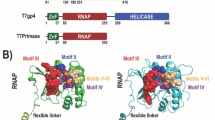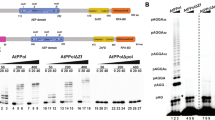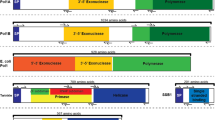Abstract
An open reading frame from Arabidopsis thaliana, which is highly homologous to the human mitochondrial DNA helicase TWINKLE, was previously cloned, expressed, and shown to have DNA primase and DNA helicase activity. The level of DNA primase activity of this Arabidopsis Twinkle homolog (ATH) was low, perhaps due to an incomplete zinc binding domain (ZBD). In this study, N-terminal truncations of ATH implicate residues 80–102 interact with the RNA polymerase domain (RPD). In addition, chimeric proteins, constructed using domains from ATH and the well-characterized T7 phage DNA primase–helicase gp4, were created to determine if the weak primase activity of ATH could be enhanced. Two chimeric proteins were constructed: ATHT7 contains the ZBD and RPD domains of ATH tethered to the helicase domain of T7, while T7ATH contains the ZBD and RPD domains of T7 tethered to the helicase domain of ATH. Both chimeric proteins were successfully expressed and purified in E. coli, and assayed for traditional primase and helicase activities. T7ATH was able to generate short oligoribonucleotide primers, but these primers could not be cooperatively extended by a DNA polymerase. Although T7ATH contains the ATH helicase domain, it exhibited few of the characteristics of a functional helicase. ATHT7 lacked primase activity altogether and also demonstrated only weak helicase activities. This work demonstrates the importance of interactions between structurally and functionally distinct domains, especially in recombinant, chimeric proteins.








Similar content being viewed by others
References
Bogenhagen D, Clayton DA (1977) Mouse L cell mitochondrial DNA molecules are selected randomly for replication throughout the cell cycle. Cell 11(4):719–727. doi:10.1016/0092-8674(77)90286-0
Falkenberg M, Larsson N-G, Gustafsson CM (2007) DNA replication and transcription in mammalian mitochondria. Annu Rev Biochem 76(1):679–699. doi:10.1146/annurev.biochem.76.060305.152028
Lee S-J, Richardson CC (2011) Choreography of bacteriophage T7 DNA replication. Curr Opin Chem Biol 15(5):580–586. doi:10.1016/j.cbpa.2011.07.024
Benkovic SJ, Valentine AM, Salinas F (2001) Replisome-mediated dna replication. Annu Rev Biochem 70(1):181–208. doi:10.1146/annurev.biochem.70.1.181
Tabor S, Richardson CC (1981) Template recognition sequence for RNA primer synthesis by gene 4 protein of bacteriophage T7. Proc Natl Acad Sci USA 78(1):205–209
Korhonen JA, Pham XH, Pellegrini M, Falkenberg M (2004) Reconstitution of a minimal mtDNA replisome in vitro. EMBO J 23(12):2423–2429. doi:10.1038/sj.emboj.7600257
Holt IJ, Lorimer HE, Jacobs HT (2000) Coupled leading- and lagging-strand synthesis of mammalian mitochondrial DNA. Cell 100(5):515–524. doi:10.1016/S0092-8674(00)80688-1
Brown TA, Cecconi C, Tkachuk AN, Bustamante C, Clayton DA (2005) Replication of mitochondrial DNA occurs by strand displacement with alternative light-strand origins, not via a strand-coupled mechanism. Genes Dev 19(20):2466–2476. doi:10.1101/gad.1352105 19/20/2466 [pii]
Farge G, Holmlund T, Khvorostova J, Rofougaran R, Hofer A, Falkenberg M (2008) The N-terminal domain of TWINKLE contributes to single-stranded DNA binding and DNA helicase activities. Nucleic Acids Res 36(2):393–403. doi:10.1093/nar/gkm1025
Wanrooij S, Fusté JM, Farge G, Shi Y, Gustafsson CM, Falkenberg M (2008) Human mitochondrial RNA polymerase primes lagging-strand DNA synthesis in vitro. Proc Natl Acad Sci 105(32):11122–11127. doi:10.1073/pnas.0805399105
Fusté JM, Wanrooij S, Jemt E, Granycome CE, Cluett TJ, Shi Y, Atanassova N, Holt IJ, Gustafsson CM, Falkenberg M (2010) Mitochondrial RNA polymerase is needed for activation of the origin of light-strand DNA replication. Mol Cell 37(1):67–78. doi:10.1016/j.molcel.2009.12.021
Arai K, Kornberg A (1979) A general priming system employing only dnaB protein and primase for DNA replication. Proc Natl Acad Sci USA 76(9):4308–4312
Bouche JP, Zechel K, Kornberg A (1975) dnaG gene product, a rifampicin-resistant RNA polymerase, initiates the conversion of a single-stranded coliphage DNA to its duplex replicative form. J Biol Chem 250(15):5995–6001
Frick DN, Richardson CC (1999) Interaction of bacteriophage T7 Gene 4 primase with its template recognition site. J Biol Chem 274(50):35889–35898. doi:10.1074/jbc.274.50.35889
Crute JJ, Lehman IR (1991) Herpes simplex virus-1 helicase-primase. Physical and catalytic properties. J Biol Chem 266(7):4484–4488
Cao Y (2012) A biofunctional Mitochondrial DNA Primase/Helicase (AMH) Identified in Arabidopsis Thaliana: Preliminary Biochemical Characterization of its Functions. Dissertation, Clark University
Diray-Arce J, Liu B, Cupp J, Hunt T, Nielsen B (2013) The Arabidopsis At1g30680 gene encodes a homologue to the phage T7 gp4 protein that has both DNA primase and DNA helicase activities. BMC Plant Biol 13(1):36
Wurch T, Lestienne F, Pauwels PJ (1998) A modified overlap extension PCR method to create chimeric genes in the absence of restriction enzymes. Biotechnol Tech 12(9):653–657
Mendelman LV, Richardson CC (1991) Requirements for primer synthesis by bacteriophage T7 63-kDa gene 4 protein. Roles of template sequence and T7 56 kDa gene 4 protein. J Biol Chem 266(34):23240–23250
Kusakabe T, Richardson CC (1997) Gene 4 DNA primase of bacteriophage T7 mediates the annealing and extension of ribo-oligonucleotides at primase recognition sites. J Biol Chem 272(19):12446–12453
Kusakabe T, Richardson CC (1997) Template recognition and ribonucleotide specificity of the dna primase of bacteriophage T7. J Biol Chem 272(9):5943–5951. doi:10.1074/jbc.272.9.5943
Qimron U, Lee SJ, Hamdan SM, Richardson CC (2006) Primer initiation and extension by T7 DNA primase. EMBO J 25(10):2199–2208. doi:10.1038/sj.emboj.7601112
Matson SW, Richardson CC (1983) DNA-dependent nucleoside 5′-triphosphatase activity of the gene 4 protein of bacteriophage T7. J Biol Chem 258(22):14009–14016
Frick DN, Baradaran K, Richardson CC (1998) An N-terminal fragment of the gene 4 helicase/primase of bacteriophage T7 retains primase activity in the absence of helicase activity. Proc Natl Acad Sci USA 95(14):7957–7962
Nakai H, Richardson CC (1986) Interactions of the DNA polymerase and gene 4 protein of bacteriophage T7. Protein-protein and protein-DNA interactions involved in RNA-primed DNA synthesis. J Biol Chem 261(32):15208–15216
Nakai H, Richardson CC (1988) Leading and lagging strand synthesis at the replication fork of bacteriophage T7. Distinct properties of T7 gene 4 protein as a helicase and primase. J Biol Chem 263(20):9818–9830
Lee SJ, Richardson CC (2001) Essential lysine residues in the RNA polymerase domain of the gene 4 primase–helicase of bacteriophage T7. J Biol Chem 276(52):49419–49426. doi:10.1074/jbc.M108443200 M108443200 [pii]
Carrie C, Kühn K, Murcha MW, Duncan O, Small ID, O’Toole N, Whelan J (2009) Approaches to defining dual-targeted proteins in Arabidopsis. Plant J 57(6):1128–1139. doi:10.1111/j.1365-313X.2008.03745.x
Claros MG, Vincens P (1996) computational method to predict mitochondrially imported proteins and their targeting sequences. Eur J Biochem 241(3):779–786. doi:10.1111/j.1432-1033.1996.00779.x
Larkin MA, Blackshields G, Brown NP, Chenna R, McGettigan PA, McWilliam H, Valentin F, Wallace IM, Wilm A, Lopez R, Thompson JD, Gibson TJ, Higgins DG (2007) Clustal W and Clustal X version 2.0. Bioinformatics 23(21):2947–2948. doi:10.1093/bioinformatics/btm404
Zhu B, Lee S-J, Richardson CC (2010) Direct role for the RNA polymerase domain of T7 primase in primer delivery. Proc Natl Acad Sci 107(20):9099–9104. doi:10.1073/pnas.1004220107
Kusakabe T, Hine AV, Hyberts SG, Richardson CC (1999) The Cys4 zinc finger of bacteriophage T7 primase in sequence-specific single-stranded DNA recognition. Proc Natl Acad Sci 96(8):4295–4300. doi:10.1073/pnas.96.8.4295
Kato M, Ito T, Wagner G, Ellenberger T (2004) A molecular handoff between bacteriophage T7 DNA primase and T7 DNA polymerase initiates DNA synthesis. J Biol Chem 279(29):30554–30562. doi:10.1074/jbc.M403485200 M403485200 [pii]
Guo S, Tabor S, Richardson CC (1999) The linker region between the helicase and primase domains of the bacteriophage T7 gene 4 protein is critical for hexamer formation. J Biol Chem 274(42):30303–30309
Spelbrink JN, Li FY, Tiranti V, Nikali K, Yuan QP, Tariq M, Wanrooij S, Garrido N, Comi G, Morandi L, Santoro L, Toscano A, Fabrizi GM, Somer H, Croxen R, Beeson D, Poulton J, Suomalainen A, Jacobs HT, Zeviani M, Larsson C (2001) Human mitochondrial DNA deletions associated with mutations in the gene encoding Twinkle, a phage T7 gene 4-like protein localized in mitochondria. Nat Genet 28(3):223–231. doi:10.1038/90058 90058 [pii]
Thompson JD, Higgins DG, Gibson TJ (1994) CLUSTAL W: improving the sensitivity of progressive multiple sequence alignment through sequence weighting, position-specific gap penalties and weight matrix choice. Nucleic Acids Res 22(22):4673–4680. doi:10.1093/nar/22.22.4673
Patel G, Johnson DS, Sun B, Pandey M, Yu X, Egelman EH, Wang MD, Patel SS (2011) A257T linker region mutant of T7 helicase-primase protein is defective in DNA loading and rescued by T7 DNA polymerase. J Biol Chem 286(23):20490–20499. doi:10.1074/jbc.M110.201657
Zhu B, Lee S-J, Richardson CC (2009) An in trans interaction at the interface of the helicase and primase domains of the hexameric gene 4 protein of bacteriophage T7 modulates their activities. J Biol Chem 284(35):23842–23851. doi:10.1074/jbc.M109.026104
Ahnert P, Patel SS (1997) Asymmetric interactions of hexameric bacteriophage T7 DNA helicase with the 5′- and 3′-Tails of the forked DNA substrate. J Biol Chem 272(51):32267–32273. doi:10.1074/jbc.272.51.32267
Patel SS, Picha KM (2000) Structure and function of hexameric helicases1. Annu Rev Biochem 69(1):651–697. doi:10.1146/annurev.biochem.69.1.651
Kato M, Ito T, Wagner G, Richardson CC, Ellenberger T (2003) Modular architecture of the bacteriophage T7 primase couples RNA primer synthesis to DNA synthesis. Mol Cell 11(5):1349–1360. doi:10.1016/S1097-2765(03)00195-3
Hine AV, Richardson CC (1994) A functional chimeric DNA primase: the Cys4 zinc-binding domain of bacteriophage T3 primase fused to the helicase of bacteriophage T7. Proc Natl Acad Sci USA 91(25):12327–12331
Kusakabe T, Richardson CC (1996) The role of the zinc motif in sequence recognition by DNA primases. J Biol Chem 271(32):19563–19570
Washington MT, Rosenberg AH, Griffin K, Studier FW, Patel SS (1996) Biochemical analysis of mutant T7 Primase/helicase proteins defective in dna binding, nucleotide hydrolysis, and the coupling of hydrolysis with dna unwinding. J Biol Chem 271(43):26825–26834. doi:10.1074/jbc.271.43.26825
Acknowledgments
This work was supported by National Institutes of Health [Grant Number R15-GM086838-01A1, awarded to DJC]. We are grateful to Tatenda Kadungure, and Abhijit Srungavarapu for exceptional technical assistance.
Author information
Authors and Affiliations
Corresponding author
Electronic supplementary material
Below is the link to the electronic supplementary material.
Rights and permissions
About this article
Cite this article
Towle-Weicksel, J.B., Cao, Y., Crislip, L.J. et al. Chimeric proteins constructed from bacteriophage T7 gp4 and a putative primase–helicase from Arabidopsis thaliana . Mol Biol Rep 41, 7783–7795 (2014). https://doi.org/10.1007/s11033-014-3671-y
Received:
Accepted:
Published:
Issue Date:
DOI: https://doi.org/10.1007/s11033-014-3671-y




